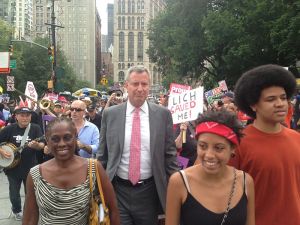Squaring Bill de Blasio’s Ideology With Real Estate Accounting
By Billy Gray November 12, 2013 10:00 am
reprintsThe question of whether New York’s first family-elect will live in Gracie Mansion has momentarily become the biggest real estate story of Bill de Blasio’s fresh, landslide mayoral victory.
But despite a well-publicized thawing of sorts between Mr. de Blasio and the business and real estate elite in the last weeks of the mayor’s race, the left-leaning Democrat will soon legislate development and taxes rather than murkily tackle them through oratory.
Some real estate tax specialists are uneasy about the de Blasio administration.
 “In my humble opinion, he’s a problem,” said Neil Sonenberg of Rosen Seymour Shapss Martin & Company LLP, who mentioned the 421-a and J-51 abatement programs as incentives Mr. de Blasio might take to task. “All the things that developers like to have in their inventory he wants taken away.”
“In my humble opinion, he’s a problem,” said Neil Sonenberg of Rosen Seymour Shapss Martin & Company LLP, who mentioned the 421-a and J-51 abatement programs as incentives Mr. de Blasio might take to task. “All the things that developers like to have in their inventory he wants taken away.”
Ken Weissenberg of EisnerAmper LLP said that the Industrial & Commercial Abatement Program would “probably be eliminated, at least in Manhattan.”
Indeed, the Park Slope mayor’s tenure may be marked by a shift in focus to the outer boroughs. Saul Brenner, a tax partner at Berdon LLP, suggested that the most influential of Mr. de Blasio’s proposed changes to real estate accounting would involve vacant lots outside of Manhattan. The mayor-elect embraced a 2012 proposal by the New York City Independent Budget Office to amend the assessment and classification of such residential lots.
Currently, if vacant residential land is outside of Manhattan, is no larger than 10,000 square feet and is immediately adjacent to and shares an owner with property with a residential structure, the land is taxed as a Class 1 residential property. That classification translates to an assessment of no more than 6 percent of fair market value.
“What de Blasio has said is that he embraces a proposal that each vacant lot with an area of 2,500 square feet or more would be taxed as a Class 4 or commercial property, which is assessed at 45 percent of market value,” Mr. Brenner said.
He added that under the current system there’s a cap on how much the annual assessments can increase. Under the proposed plan, there is no cap. Out of the 24,600 vacant residential properties that are currently Class 1, about 13,400 would be reclassified.
“He wants to discourage long-term speculation,” Mr. Brenner said. “And take the additional real estate tax revenues and put them in a fund to create, shall we say, middle-class housing.”
And while Mr. de Blasio has said he’d extend the 421-a abatement that encourages the construction of affordable units through incentives, he has denounced the program benefitting super-luxury condo towers and has strongly condemned such structures replacing hospitals and, more broadly, undoing the fabric of economic integration through the city.
Fundamentally, Mr. Brenner said the mayor-elect has “made it very clear that the relationship between NYC and the real estate developer community needs a reset.”


